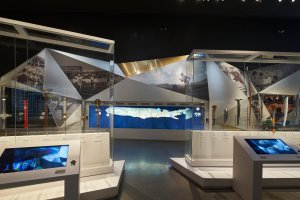How Panasonic is making Olympics history immersive

- New and interactive ways to immerse museum visitors are developed with emerging technology
- Museums and public exhibition face additional challenges to enforce social distancing amid the global pandemic
Matsushita Electric, the company that was to become Panasonic, was founded in 1918 by Kōnosuke Matsushita as a vendor of duplex lamp sockets. With a history of over a century. Panasonic is now a top sponsor of the Olympics and Paralympics.
“At the time of our founding, the founder Konosuke Matsushita foresaw the coming of the age of electrification. That prescience, and the clear path he lay down, led to the development of the Panasonic we know today.”
These were the words shared by Kazuhiro Tsuga, the current President of Panasonic, at the opening of the Panasonic Museum in Kadoma City, Osaka.
Now it seems like Panasonic is stepping into the digital age and envision its technology and legacy to play a significant role in creating an immersive and interactive experience for museums.
Speaking to TechHQ, Joseph Conover, National Manager, Panasonic System Solutions Company of North America, shared his insights on how Panasonic has helped the newly launched US Olympics and Paralympics museum develop immersive experience.
The US Olympic & Paralympic Museum, located in southwest downtown Colorado Springs (also the Olympic City), officially opened on July 30 this year. The 60,000-square foot building features 12 galleries that follow the narrative of US athletes and their journeys, telling their story in a personalized way.

Source: Panasonic
“The whole museum was designed around the concept of being inclusive and immersive,” Conover said. “How can we make each interactive experience to be immersive and inclusive of everybody. And that, quite frankly, is a unique challenge.”
Early engagement is key
Bearing in mind the rapid pace of technology evolving, technology used in museums can quickly become outdated even before its opening. To this predicament, Conover elaborated on the importance of early engagement.
“It’s very hard for a museum to pivot and refresh equipment because that budget is no longer available,” said Conover, since “technology ages rather quickly” and “upon opening, X amount of time has passed.”
In this regard, early engagement in the process of development has allowed Panasonic to “kind of peek behind the curtain” and know “some things that were under concept at the time,” placing the company at the heart of the design and development of the museum through its creation.
Conover told TechHQ, by having Panasonic as a consulting partner during the early stages of discussions “where the museum and the teams of designers, content, and developers had a thoughtful conversation of what was to become” and the technology employed is “really where the partnership worked really well.”
One of the main reasons being Panasonic is able to “understand the viewpoints” and “thoughtfully make suggestions as to what technology, they’re going to come about in this interval of X amount of months to this entity come to fruition.”
This ignites a collateral impact in a museum’s budgeting, which encompasses the servicing and maintenance for the longevity of equipment. Essentially, appropriate budgeting with room for emerging technology and potential maintenance is allocated, “instead of spending capital on it for one time and then trying to refresh down the road,” as Conover added.
Conover also shared with TechHQ the swift adaption of technology to accommodate the current norm of social distancing in public spaces. “Most recently, we’re doing a lot of things within the United States to provide solutions in response to COVID-19,” and the technologies utilized throughout the museum is now assigned “to create an immersive experience for all is now utilize for another purpose and some of that purposes social distancing.”
The technology employed is now purposed to enforce social distancing and central around minimal contact to offer services from the entrance to the museum to sales in gift shops.
“We have touchless registration with our scanning solutions and tools […] We have ID scan process that we utilize on our handheld tablets, touchless entry with thermal ID scans, touch plus point to sale, and smart locker solutions.”
In a bid to accentuate the immersive experience in museums, projectors and LED displays are the official solutions used to “communicate and distribute media throughout.” At the same time, Conover added that camera-related technology such as video analytics are utilized to see if people are wearing masks or if social distancing guidelines are followed.
Conover remarked the experience was “a quick pivot” that saw “technology that was more experience-oriented to be now more safety-oriented.”
This is another takeaway for businesses to learn how partnership and early engagement presents not only a suite of solutions but also helps businesses sail through an unexpected crisis.










